Ingredients:
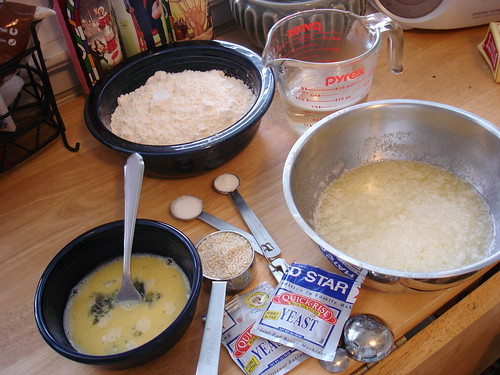
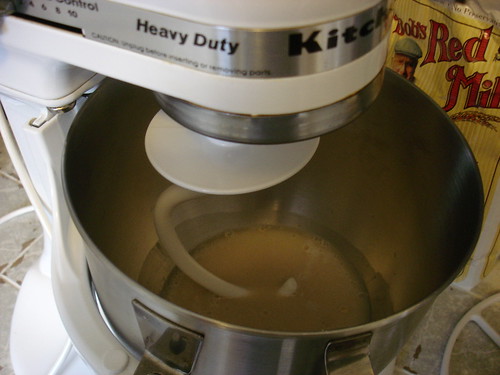
Then I added 1 cup of the flour and the salt. Blended again, then added the melted butter (it should not be hot, let it cool off a bit). If by hand, beat 40-50 strokes. If with mixer, roughly the same amount of strokes. Basically, you want them well-blended. I added the rest of the flour, 1/2 cup at a time so as to bring the dough around easily and gently. Dump it in all at once and you may end up with a cannonball.
Once a dough starts to form, you're no longer mixing the ingredients, but kneading them. I kneaded it on a low speed for about 5 minutes. Over-kneading, various bread-makers warn, can make the dough tough and not very tasty. I desperately do not want tough and untasty dough, no sir!
I apologize for this picture, as I admit it is not very appetizing-looking. But I wanted to show what the author means when he says the dough should be soft and elastic, not sticky at all:
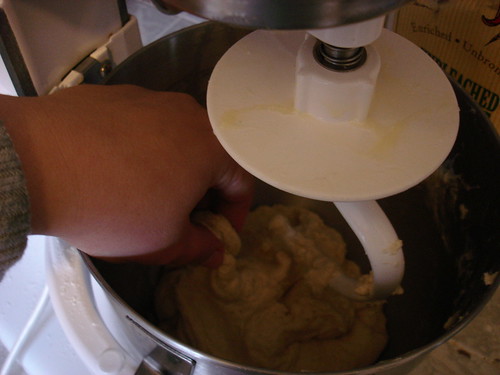
It's no longer sticking to the sides of the bowl. The folds show you that it's soft, and as I pull a portion of it up, it's pliable. So, we've got dough.
Now we put it in a bowl to rise.
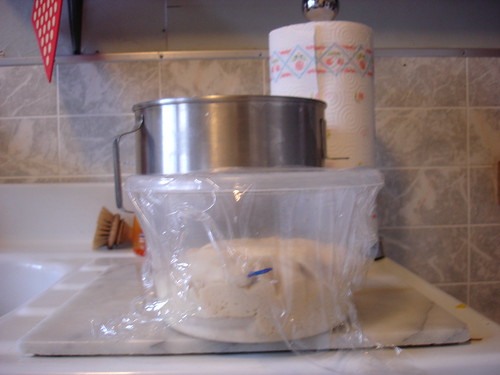
It needs to rise to double the amount of the original size of the dough. I marked it with a marker, because I was using one of those disposable containers and don't care if it gets marked up. If I'd had a rubber band, I would have just wrapped it around the bowl to mark the starting point, that way I would know when it doubled in size.
Some observations: a tall-sided bowl, I think, gives you a good idea of the rise. I also liked using a clear vessel, for ease of observation. You are supposed to let it sit and rise in a room that's about 75 degrees, which is normally considered room temperature. It's winter here, and I'm a miser who doesn't turn up her thermostat past 69. In case you are in a cold environment, boil 2 cups of water in the microwave. Once it boils, stick the container in there and leave the water in there too. That should help create a warmer temperature. Too warm a temperature, and it will rise very quickly, so those of you in PR, take note of that.
This actually happened to me. The recipe said it would take about 2 hours to rise, but in after the microwave trick it only took 1. Moral of the story - rising times are approximate, the conditions in your kitchen will ultimately affect how long it takes. So, keep an eye on it.
With the dough risen (sorry, forgot to take a picture of that!), it's time to start shaping the dough.
The recipe says it should yield 24 sumsums, so I shaped the pieces of dough according to that figure. I placed them on a cookie sheet covered in parchment paper to prevent the bottoms from burning. Then I rolled them out into into balls. Really go to town on this, as my 9th grade English teacher Mrs. Riefkohl used to say when she urged us to "go to town on your essays": cup them in your hands and vigorously ball them up (stop snickering) -- this helped keep them in shape. Flour your hands with each one so they don't get damp and slippery. If they are dry they will hold their shape better.

Now we roll them up so they are approximately six inches long. Again, flour up your hands and the work surface when you do this. I started them out between both my hands to form the basic shape, then finished the job by rolling it between my palm and the work surface to get the length:
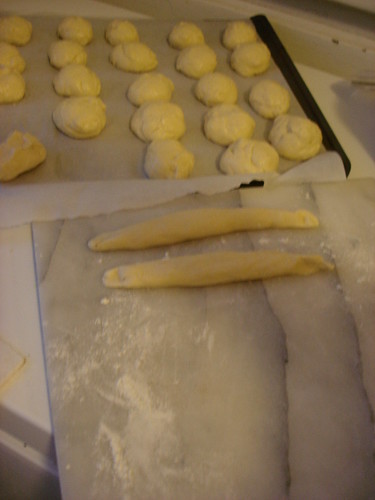
Woot! Now, to roll them up. You curl them around your index finger, and you let the ends overlap each other. Kind of looks like a tortellini, doesn't it?
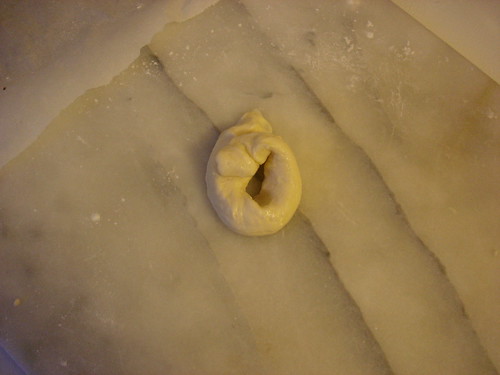
Now is when you start to preheat your oven to 375 degrees, as they will need some time to rest. Once it reaches temperature, brush them with the beaten egg and sprinkle on the sesame seeds, as much or as little as you'd like. Arrange them about an inch and a half apart on the sheet. In the oven they go.
The recipe, curiously, doesn't say how long to bake them for -- only to bake them till they are golden yellow. I made two batches, and discovered that by the time they turn very golden yellow, they are too crispy. Pale golden yellow is the way to go, as it yields a slightly crunchy crust with a soft, buttery interior. Did I say buttery? I meant BUTTERY. You can see the layer of butter inside the bun. If you like butter - and to me, butter is only rivaled by bacon when it comes to its taste sensation - you will love this. I can see why it is served simply with tea or coffee, as it doesn't really need much adornment. I would recommend setting your timer to 20 minutes, checking it, and increasing the cook time by 5 minutes incrementally. My magic number was 25 minutes.
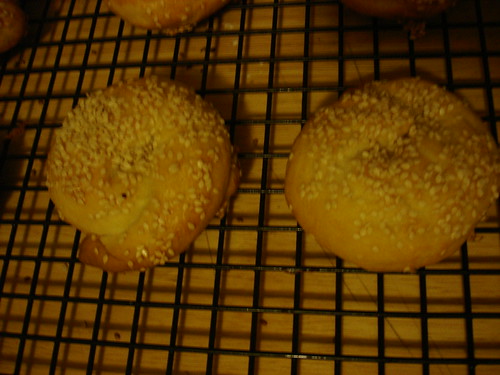
If there are any Syrian Jews in Portland looking for a Sabbath snack, I can totally hook you up.
Recipe from The Breads of France: And How to Bake Them in Your Own Kitchen, by Bernard Clayton, Jr.





No comments:
Post a Comment